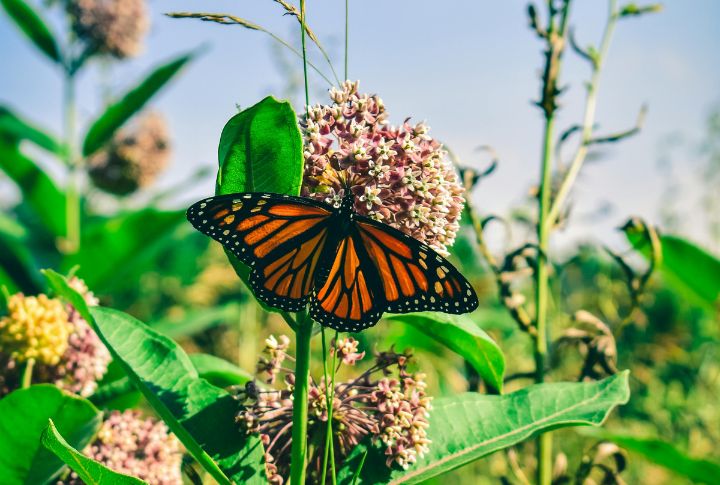
Every spring, gardeners wait for a familiar flash of orange wings to glide into their yards. Monarch butterflies, the symbols of transformation and endurance, have long enchanted both scientists and casual observers. Yet, in recent years, something feels wrong. Monarch populations have plummeted across North America. Habitat loss, pesticides, and climate shifts are part of the problem.
But even well-meaning gardeners—those planting what they believe are “butterfly-friendly” flowers—might be unknowingly worsening the crisis. So, let’s find out what exactly is leading to this decline.
The Connection Between Monarchs And Milkweed
Monarch butterflies depend on milkweed as if it were air or water. Every stage of their life cycle ties back to it. Female monarchs specifically lay their eggs on milkweed plants, and once hatched, the caterpillars feed exclusively on milkweed leaves. This diet makes them unappetizing to predators due to the plant’s natural toxins.
For years, conservation campaigns have urged people to “plant milkweed to save the monarchs.” The message spread widely. Gardeners, schools, and community parks responded with enthusiasm. But few realized that not all milkweed species are created equal—and that one particular variety might be doing more harm than good.
The Wrong Kind Of Milkweed
The main suspect is tropical milkweed, scientifically known as Asclepias curassavica. Its appeal is easy to understand. With fiery red and yellow flowers that bloom almost year-round, it’s a showstopper in any garden. Nurseries promote it as a “monarch magnet,” often placing it front and center in butterfly plant displays.
However, tropical milkweed’s beauty hides a dangerous flaw. Unlike native milkweed species, which die back during winter, tropical milkweed continues to grow in warm climates. This disrupts the natural migration cues that monarchs rely on. Instead of moving south to overwintering grounds, butterflies linger where they shouldn’t.
A Trap Disguised As A Sanctuary
At first, a steady food supply might sound like a good thing. After all, if milkweed remains available, shouldn’t monarchs thrive? Sadly, the opposite happens. Tropical milkweed tricks monarchs into staying and breeding in the same place for too long.
This creates what researchers call “ecological traps”—habitats that look beneficial but ultimately endanger the species. The constant presence of milkweed encourages monarchs to reproduce out of season. Caterpillars hatch at the wrong time, adults miss migration windows, and the population becomes more vulnerable to disease.
The Silent Threat Of OE Infection
The problem deepens with a microscopic parasite called Ophryocystis elektroscirrha (OE). This protozoan spreads through contact with infected butterflies and contaminated milkweed leaves. When caterpillars consume infected tissue, the parasite multiplies inside their bodies. By the time they emerge as adults, their wings are weak and their flight is often impossible.
Under normal conditions, the parasite’s spread is limited, as native milkweeds die back each year, naturally cleansing the environment.
How Garden Centers Add To The Confusion
Many gardeners fall into the tropical milkweed trap because of misleading labeling. Nurseries often sell Asclepias curassavica as “butterfly milkweed,” a name it shares with the native Asclepias tuberosa. The plants look similar to untrained eyes, and tags rarely specify which species are native.
Even environmentally conscious buyers might not know the difference. The bright flowers look inviting, the name sounds right, and the promise of attracting monarchs is irresistible. Unfortunately, those same plants can unintentionally sabotage the very butterflies they’re meant to protect.
Learning To Work With Nature’s Calendar
Restoring balance means understanding nature’s timing. Native milkweed varieties sprout in spring, grow through summer, and fade as fall approaches. This cycle aligns perfectly with the monarch’s breeding and migration schedule. The plants thrive when butterflies need them most, then disappear to make way for the next stage of the journey.
Gardeners can replicate this balance by mimicking natural cycles. Cutting back tropical milkweed during late fall—before frost—forces it into dormancy, reducing OE spores and helping reestablish migratory behavior. Better yet, replacing it entirely with native species ensures the environment heals naturally.
The Power Of Small Corrections
The encouraging news is that it doesn’t take a massive change to make a difference. Replacing a few tropical milkweed plants with native ones can start restoring local migration routes. As more gardeners make the switch, regional networks of healthy habitats begin to reconnect.
Communities that organize native plant swaps or educational workshops often see quick results. Monarch sightings increase, and healthy caterpillars return to gardens where none had been seen in years. Each action, no matter how small, ripples outward into the broader landscape.
The Path Forward
Saving the monarch butterfly isn’t about grand gestures. It’s about awareness, adaptation, and small steps taken collectively. Every gardener who replaces tropical milkweed with native species becomes part of a restoration movement stretching across continents.
When spring comes again and the orange wings return, it will be a homecoming, earned through understanding and care. So, the next time you see a monarch glide across your garden, you’ll know your hands helped write that story.

